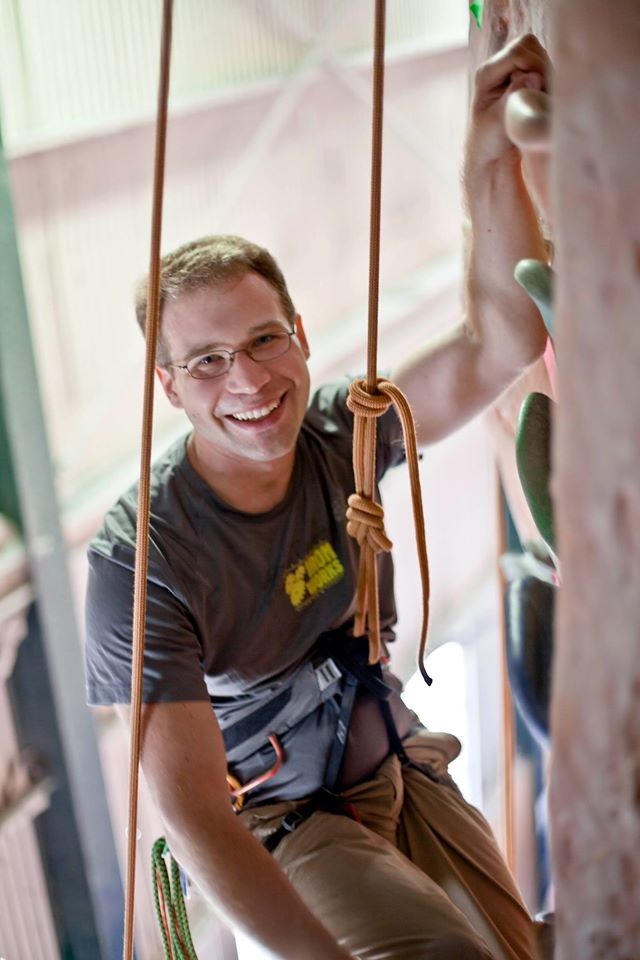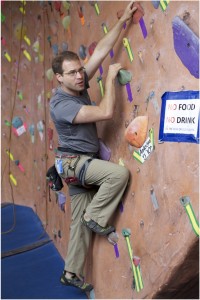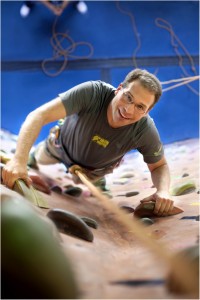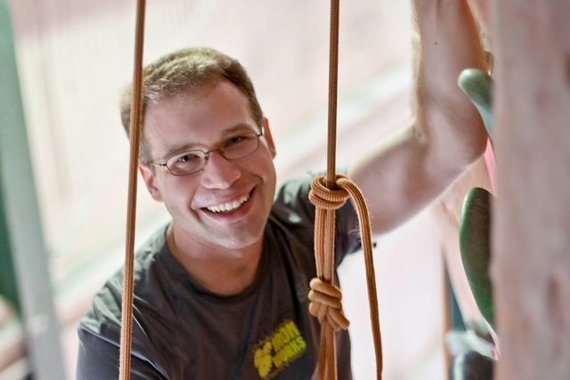
Photo: Devan Perez
I’m at a podium in front of 50 medical professionals, flanked by two professors of physical therapy, humbled by my 20th viewing of a video in which I completely fail to climb past an overhang on a 5.7 in the gym, and frustrated in an attempt to explain why—despite the fiery pain and the lack of evidence of any benefit—I actually like static hamstring stretches.
Failing on the overhang:
I finally give up, and in that surrender comes inspiration:
You know,
I say to my questioner,
there’s a nursery rhyme that explains this pretty well.
I begin to sing:
I love to keep banging my head on the wall
said the young boy to his pop.
I love to keep banging my head on the wall
because it feels good when I stop.
I keep thinking about that nursery rhyme. I’ve spent much of the last 18 months as a science experiment—being videotaped climbing, popping into a laboratory for movement analysis, and then marshaling the data with my professor-collaborators to prove that people with disabilities can benefit from climbing, and that exercise “prescription” focused on individual deficits can improve both climbing and overall function.
Footage from the movement analysis:
The presentations we give speak of three-dimensional gait analysis, power production and absorption at the knee and hip during gait, and rate of force development in spastic muscle. The point is much simpler: anyone with sufficient motivation can climb; if you work hard on the things you don’t do well, you will get better; and climbing has plenty of physical—and emotional—benefits.
Paradoxically, in the midst of all that, I stopped climbing. One of my favorite belay partners had moved away, and another had a slow-healing foot injury. I told myself that that’s why I stopped. I told myself that Laurie and Kelda weren’t around, and that I was too busy coaching little kids to climb. I was lying to myself. There were much deeper reasons.

Photo: Devan Perez
I have Cerebral Palsy (CP), and I’ve spent most of my 37 years being the poster boy—the articulate, good-natured, optimistic one who, having gotten groundbreaking surgery more than 25 years ago, went on to get a biomedical engineering degree from Johns Hopkins, started his own business at the age of 26, began climbing on a whim at age 34, and got hooked on the pure joy of it.
I’m someone’s success story—but I’ve had a much harder time defining success for myself. The work I’ve been doing—allowing myself to be studied, giving scientific talks on climbing and disabilities—is important, even vital. Someone has to stand up for people with disabilities, and too few are willing. But it’s hard to be reduced to a précis of diagnoses and deficits, to defend one’s humanity before a pack of the bruisingly, clinically curious.
All of it drained me, reduced climbing to an abstraction, and sapped the very joy that fueled my climbing in the first place. That’s why I stopped climbing.
Or is it?
It’s easy to blame a disability, and equally easy to blame the faceless Medical Establishment and its invasive curiosity for one’s issues. It’s a peculiar species of pity party endemic to those with disabilities—and one that few outsiders have the courage to challenge. Fortunately, I’ve been lucky. I had a smart athletic trainer, and one day, I walked into his gym and was morose about some minor setback I was having. My trainer stopped me:
Andrew, what’s your problem? Every time you come in here, you tell me that you’re doing exactly what you want to do—hiking, walking around Venice with all the steps it had—so either you need new goals, or you need a better attitude!
Indeed.
In the last month, I’ve slowly stopped wallowing in Weltschmerz. I’ve slowly started climbing again. To do that, though, I’ve had to strip away much that was there. My climbing had become too much about being Andrew-the-climber-who-has-CP and too little about just climbing. I’d lost the glee of being high up above the ground and looking out with new appreciation on that which was below. I’d let myself buy-in to a load of crap that had nothing to do with climbing.
Load of crap, part one: the Yosemite decimal system (YDS).
I’m on video falling repeatedly on a 5.7 overhang. On a good day, I onsighted a slab 5.10b in the gym. I’ve climbed innumerable 5.10a routes, sometimes campusing when my legs simply won’t reach where I need them to go. I was so excited when I finished my first 5.10b that I hollered to my friends at the gym’s front desk from 30 feet away and 40 feet up. The problem is that I allowed those numbers, those grades, to define me as a climber. I got hung up on whether I was a “true” 5.10a or 5.10b climber and allowed that to consume my entire experience of climbing. I don’t think that problem is unique to me.
Alan Moore recently wrote a wonderful article on “Dude Grades,” the gender bias inherent in most grading, and his observations ring true for me, too. To paraphrase, I have CP—
this physiological fact has a profound impact on [my] relationship with climbing grades.
However, I don’t think the answer is to come up with some separate-but-equal system of grades for people who don’t have standard male bodies. Rather, I think we should decouple ourselves from climbing grades.
Like any climber, I’ve had to learn terrain. I’ve had to learn how to read routes, and I’ve had to learn how to read my own body. On a good day, I trust what I’ve learned, and I trust my body. On a good day, I use my own metrics when I’m climbing: have I made three good moves in succession? Is my range of motion better than it was last week? Is this route making me think and move in unexpected ways? Most importantly, am I happy climbing this route?
If the answer to any one of those questions is yes, then the route is a good one for me, and its grade is irrelevant. Only on my worst days do I sulk about my inability to finish
that easy 5.7 over there.
I don’t reject normalization and grading entirely—in an inherently dangerous sport, we need to be sure that climbers are as prepared as they can be for what they attempt. I simply think that we should grade the routes—and not ourselves.
Load of crap, part two: body image.

Photo: Devan Perez
Ten years ago, a physical therapist gave me a sly look and a crooked grin, telling me,
You’re gonna be ripped when we’re done with you!
That was the first time I’d ever thought in terms of fitness, rather than rehabilitation. It was the first time a medical professional had ever implied to me that it was my body and that I could do whatever I wanted with it. When people are constantly cutting into your body, measuring it against norms, describing deficits and deviations, it’s hard to be gentle with yourself, to respect your body, and to explore with a clear mind and an open heart what you can do with it.
I took that comment to heart. Of course, me being me, given a choice between “ripped” and “chocolate,” I’ll more often than not choose chocolate. It’s taken me a while to accept that—barring diabetes or morbid obesity—that choice is okay.
Expectations and stereotypes pervade our society and invade what we do as climbers, and it’s hard not to succumb to them. If I say “climber,” most of you could close your eyes and imagine a body type:
- wide shoulders,
- developed back muscles,
- six-pack abs,
- and no fat anywhere.
Climbers are active people, and a fit body comes with that territory, but even stereotypes that are rooted in reality can hurt.
I still question myself when I look around the gym. I ask myself (rudely) how I feel about not having six-pack abs, about having scars on my legs, about having a pelvis that juts forward, about walking more-than-a-little like a duck. All those questions cloud my mind, and thinking about them keeps me away from the gym and off the rocks. I tell myself that diversity is good. I tell myself that conformity is good only if one is conforming to safety standards. On good days, I believe myself.
* * *
I walked back into the gym recently and saw an interesting 5.10a. It had a low, mild overhang and a stemming crux with some reachy moves very close to the top. I was overcome with the urge to try it—so much so that I decided to skip warming up and hit it at the peak of my strength and endurance. Not having climbed regularly in months, it took everything I had—I took multiple rests, my heart raced, and my entire body flushed with the effort. I reached, pushed, grunted, pulled—and grinned. I was struggling, but for the first time in months, I’d stopped banging my head on the wall.








